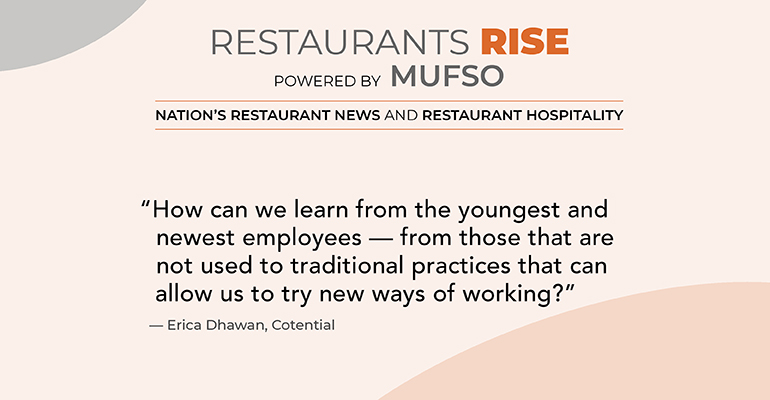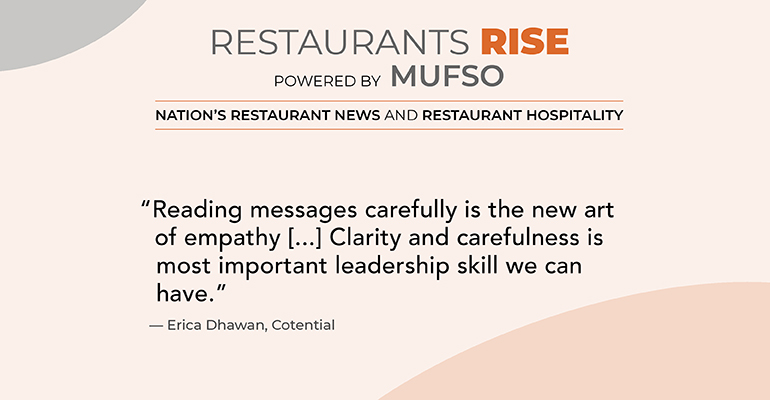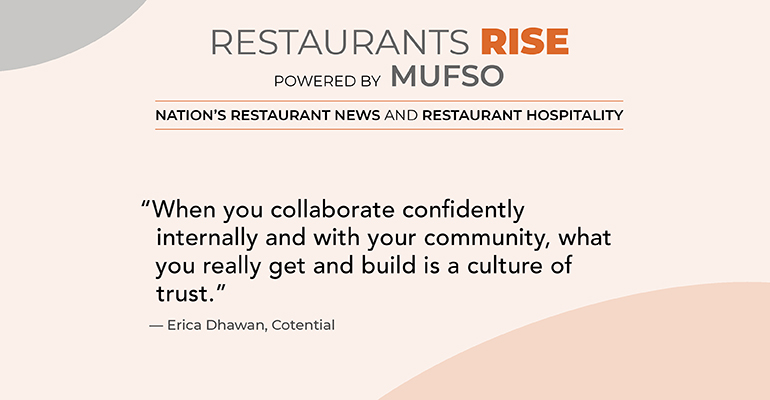Restaurants Rise powered by MUFSO, the digital community for restaurant operators and leaders, opened its afternoon of webinars on October 6 with a keynote presentation from Cotential CEO Erica Dhawan on intelligent modern communication: “Get Big Things Done: The Power of Connectional Intelligence.” As the follow-up to the emotional intelligence craze in the ‘90s, connectional intelligence Erica argues, is about learning to communicate effectively and respectfully in an age where most of our correspondences are digital, which is especially crucial now when COVID-19 has turned many American workers into telecommuters.
“In pre-COVID times, roughly 70% of our communication was virtual and today it’s 100% so it requires us to reimagine how we connect intelligently and live out digital collaboration in our new world,” Dhawan said. “We are more likely to misunderstand each other with a lack of cues; we are more likely to argue and have passive aggressiveness and more likely to walk away faster from relationships.”
Here are some ways, Dhawan argues, connectional intelligence can change the way businesses and employees can survive and thrive in a digital-first workplace:
Listen to those on the front lines
As part her presentation, Dhawan drew upon real-life examples of companies thriving with modern practices of collaboration. Dhawan pointed out that at a Lowe’s Home Improvement store, an employee noticed that customers kept returning the same dog treat. When she communicated this concern with colleagues in their Lowe’s employee digital channels, she noticed that other cashiers were experiencing the same issue of the same product being returned. Lowe’s listened to the chatter from their employees, pulled the product from their shelves, and then months later the product was recalled for being poisonous to dogs and Lowes’ competitors had to suffer the consequences.
“How can we learn from the youngest and newest employees — from those that are not used to traditional practices that can allow us to try new ways of working?” Dhawan asks. “By listening to those on the front lines […] Lowe’s was able to avoid risk management.”
 Share tasks across the company –no matter the distance
Share tasks across the company –no matter the distance
Forget about the old way of thinking: where employees were assigned their specific titles, tasks, and responsibilities and never ventured out those silos. By sharing work between workers across offices and stores, companies can better distribute tasks without overwhelming certain groups.
“Allow individuals to share tasks they need help with with other employees across company even though they’re not in the same office to create a culture where everyone can contribute,” Dhawan said.
She also suggested allowing employees to contribute ideas that are outside their usual purview and pointed to an example at Fritos-Lay where a group of Latinx employees that were not in the research and development team came up with examples of Doritos that would appeal to their demographic. That, Dhawan said, was how Guacamole Doritos were born.
Value others visibly in a virtual setting
In person, managers can show their appreciation for employees with head nods, handshakes and a verbal shoutout, but in a virtual setting, most of that communication falls by the wayside. The best way to communication appreciation is through actions:
“It’s about valuing people’s time, their inboxes and valuing the way we spend time in meetings to foster engagement and empathy,” Dhawan said.
There may actually be more examples of how not to show you value your employees than examples of how to do so. For example, canceling Zoom meetings five minutes or an hour before their scheduled time or forgetting to respond to an employee’s request.
Choose thoughtfulness over speed
Since much of our communication these days is via the written word, either through email or messages, miscommunications often happen. When you’re busy, skimming an email and misunderstanding a question can easily occur.
 She uses the example of an employee asking her boss to meet at 6 or 7:00 and he simply replies, “yes.”
She uses the example of an employee asking her boss to meet at 6 or 7:00 and he simply replies, “yes.”
“Reading messages carefully is the new art of empathy,” Dhawan said. “Clarity and carefulness is most important leadership skill we can have.”
You should also know the most appropriate forums for specific types of communication based on the complexity and importance of the message and the familiarity of the relationship. Not everything is appropriate for email, Slack, texting and/or meeting time.
Collaborate confidently and trust your team
As the old saying goes, “say what you mean and mean what you say.” If you’re on a team, the best way to build trust is to communicate openly.
“Don’t say ‘I’ll get back to you soon,’” Dhawan said. “When you collaborate confidently internally and with your community, what you really get and build is a culture of trust.”
 She suggests giving employees the benefit of the doubt and allowing for “virtual water cooler moments” or moments to really connect, even if you’re not in person together.
She suggests giving employees the benefit of the doubt and allowing for “virtual water cooler moments” or moments to really connect, even if you’re not in person together.
“Pay attention to details; what are their daily and weekly goals?” she asks.
Watch the replay of Dhawan's session here.
Register for MUFSO 2020 here, running virtual events from Oct. 1-29, Tuesdays-Thursdays 12-4:30 pm EST.
Title sponsors for MUFSO include the Coca-Cola Co., PepsiCo Foodservice and Johnsonville Foodservice.
Contact Joanna Fantozzi at [email protected]
Follow her on Twitter: @JoannaFantozzi

